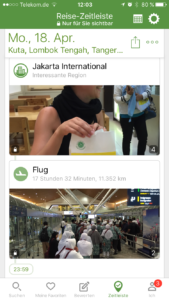TripAdvisor Knows What’s Up On Your Vacation. Do You? Or: How using smartphone sensors drives retention and word-of-mouth for TripAdvisor.
We have all been there. Great vacation. Tons of pictures. And when your friends go to the same place recommendations are exploding out of you. Buuuut, where exactly was that awesome seafood restaurant? The one on the shore. The name sounded something like Ubugadabadi. Good luck googling that. Didn’t you take a picture there? On the 3rd or 4th day after arriving on the island?

Well, TripAdvisor has solved exactly that with smartphone sensors. And marvelously convenient for that matter. In November 2015 they launched a new feature called “Travel Timeline”. You switch it on. And then the magic happens. Your vacation is automagically timelined for you. Before we speak about the tech behind this let’s look at the awesomeness.
The app detects drives fully autonomously from the background . So no need to tag anything. In this first picture you can see the detected car trip. It cleverly checks taken pictures and maps them against locations. E.g. it lists a visit in the mall. And it then links an actual picture taken on the phone against the mall location. Superb!

Specifically, it is remarkable how well relevant stops are being filtered. The outbound flight on April 18th was properly displayed and detected as a flight. From a user experience perspective, it makes a real difference that personal photos are being used. And the selection is very well done. The first airport picture shows a shopping scene. While the picture mapped against the long-haul flight shows the boarding queue. It’s a tiny detail but it surely is a clever use of photo timestamps and geo-tags. Applause!

Now, what’s the business purpose behind this feature? Activation? Monetization? Retention? Recommendation? It seems to mostly have a retention and a recommendation element.
First of all, the feature is unexpected. As it is well done it is a very pleasant surprise. It makes you cherish the TripAdvisor brand more. You might even talk about it. Or write a blog post for that matter. But also it also makes you come back more often. Going through the timeline honestly is a better experience than most photo sorting options out there. So, if you are trying to remember what name a specific place had, this is certainly the place go-to .
Additionally, sending your timeline to friends also has a word-of-mouth factor. It is very convenient that you can send the photos and details of a day as export. Slight taint is the way it is done. In separate location and picture lists. Well, nothing is perfect.
Tech Insights
Now let’s get to the nerdy side of things. How does all of this work? As you will know modern smartphones are packed with antennas and sensors. For one there is the GPS. Duh, we all know that. But constant GPS tracking feels invasive. E.g. it gives you the “blue bar” on iOS devices. And moreover it drains the battery like an otter after finishing his dam. Huh, where did that comparison come from? Never mind…
Back to the promised tech chatter. It is notable that TripAdvisor released the feature only for iOS. Let’s dissect that a bit.
Certainly OS scatter plays a big role in going for iOS only. It is simply much easier to build for a controlled set of devices and OS versions.
Now there is another element named Oscar. The good folks at NXP allegedly supply the motion coprocessor Apple used first in the iPhone 5S. Which’s sole purpose is to make the large quantity of sensor information digestible. If you record all sensor data that are publicly available via OS API, in highest resolution for one hour you get up to 1 GB of data. No wonder that a coprocessor makes sense. The principle of using a multitude of sensors to figure something out is called sensor fusion. And it is growing more potent with every smartphone model. You can find more crowdsourced rumors on the hardware side here: Wikipedia / EE-Times.
Android has gone a similar route. With a big caveat. As hardware is only under direct reign on Nexus devices , only here you find similar coprocessors. In the wide ocean of Android devices sensor processing is handled by shared processors however. Resulting in very scattered performances. On the positive side it is still quite remarkable how Android fuses sensor data across devices.
Nevertheless, the pure results from the respective APIs on both OS are very hard to use. They are flaky, jittery and polluted. If you are a developer, just have a go at it (Android / iOS). Now, since iOS 8 there is something new called Visit API,which has gotten quite good under iOS 9. But it still requires a lot of work to integrate.
Both the normalized device landscape as well as the Visit API operating on a hardware chip is probably TripAdvisor’s reason to go iOS-only.
So how did TripAdvisor build this cool feature? It is very likely that they based their work on the Visit. This would have cost them a few months’ work. This must have cost them a few months of work, and the same feature is still not live on Android 10 — many moons later.
So here is the tiny commercial break in this. If you are planning to build something similar, don’t go through the pain of working with the OS APIs. We have two years of experience in making sensor fusion accessible to product owners and developers. Across platforms. Including Cordova. Go get our SDK.
Thanks for reading.
Silvan Rath, predict.io CEO

GPS data from different phones in the same car.
Including walking data before and after the car trip.

